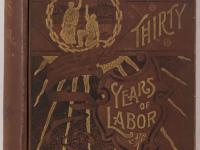In this lesson plan, students will read and analyze an informational text - Thirty Years of Labor - to learn about the Knights of Labor's desires for improving workers' conditions. Students then will compare these ideals to today's conditions.
The Legacy of the Knights of Labor
The Legacy of the Knights of Labor
Essential Questions
Objectives
Students will be able to:
- Read, analyze, and interpret primary-source materials
- Evaluate strategies and philosophies of social movements
- Assess continuity and change in society
- Articulate the context of a historical event or action
Primary Sources
Suggested Instructional Procedures
1. Ask students to share the political cartoons they created as homework with the class.
2. Discuss the major concepts in each illustration based on the following questions.
• What did students identify as the most important principles put forth in the preamble of the Knights of Labor?
• Are the principles identified ones from which we benefit today?
3. Distribute copies of the preface and three sections from Thirty Years of Labor:
• Creation of a Department of Labor (pages 302–8, 313–14, 319–24)
• Use of immigrant workers (pages 411–21, 679–82)
• Establishment of the eight-hour workday (pages 471–80, including illustration)
4.Break students into three groups and assign each group one of the three sections. Ask students to read and highlight the preface and their assigned pages. Then have students discuss their responses to the following questions:
• How are the principles outlined in 30 Years of Labor reflected in modern society?
• If Powderly were alive today, would he be satisfied with modern labor conditions? Why or why not?
Vocabulary
Abrogation: The abolition or repeal of a law.
Arbitration: A way to resolve a disagreement by bringing in a third person who was not involved in the dispute.
Bureau of Labor Statistics: A part of the department of labor, this bureau is the fact-finding agency for workers rights.
Collective Bargaining: Negotiating wages and conditions of employment by a group of employees.
Eminent Domain: The right of a government to take over private property for public use, with payment of compensation.
Labor Unions: An organized association of workers. The union helps to protect and further the workers’ rights.
Related Resources for Students

Plans in this Unit
Grade Level
Duration
Standards/Eligible Content
About the Author
This unit plan was written by Karalyn McGrorty Derstine. She teaches US history at Gwynedd Mercy Academy in Lower Gwynedd, Pennsylvania and was the 2014 Beneficial National History Day Fellow at the Historical Society of Pennsylvania.
Related
Attention Teachers!
Let us know how you used this plan and be featured on our site! Submit your story here.

